Chapter 6H. Typical Applications
Notes for Figure 6H-36—Typical Application 36
Lane Shift on Freeway
Guidance:
- The lane shift should be used when the work
space extends into either the right or left lane of a divided
highway and it is not practical, for capacity reasons, to reduce
the number of available lanes.
- When a lane shift is accomplished by using
(1) geometry that meets the design speed at which the permanent
highway was designed, (2) full normal cross-section (full lane
width and full shoulders), and (3) complete pavement markings,
then only the initial general work-zone warning sign is required.
- When the conditions in Note 2 are not met,
the information shown in the typical application should be employed
and all the following notes apply.
Standard:
- Where temporary traffic barriers are installed,
the ends of the barrier shall be treated in accordance with the
provisions of Section 6F.81.
- A warning sign shall be used to show the changed
alignment.
Guidance:
- Where the shifted section is longer than 180
m (600 ft), one set of Reverse Curve signs should be used to show
the initial shift and a second set should be used to show the
return to the normal alignment. If the tangent distance along
the temporary diversion is less than 180 m (600 ft), the Double
Reverse Curve sign should be used instead of the first Reverse
Curve sign. The second Reverse Curve sign should be omitted.
- If a STAY IN LANE sign is used, then solid
white lane lines should be used.
Standard:
- The minimum width of the shoulder lane shall
be 3 m (10 ft).
- For long-term stationary work, existing conflicting
pavement markings shall be removed and temporary markings shall
be installed before traffic patterns are changed.
Option:
- For short-term stationary work, lanes may be
delineated by channelizing devices or removable pavement markings
instead of temporary pavement markings.
- Three Lane Reverse Curve signs may be used in
place of the Reverse Curve signs. ALL LANES THRU supplemental
plaques may be used to emphasize the point that all lanes shift
and no lanes are closed.
- If the shoulder cannot adequately accommodate
trucks, trucks may be directed to use the travel lanes.
- The barrier shown in this typical application
is one method that may be used to close a lane for a long-term
project.
Guidance:
- The use of a barrier should be based on engineering
judgment.
Option:
- Type C Steady-Burn warning lights may be placed
on channelizing devices and the barrier parallel to the edge of
pavement for nighttime lane closures.
Figure
6H-36 Lane Shift on Freeway (TA-36)
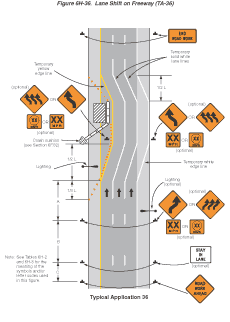
Notes for Figure 6H-37—Typical Application 37
Double Lane Closure on Freeway
Guidance:
- Ordinarily, the preferred position for the
second arrow panel is in the closed exterior lane at the beginning
of the second merging taper. However, the second arrow panel should
be placed in the closed interior lane at the end of the second
merging taper in the following situations:
- When a shadow vehicle is used in the interior
closed lane, and the second arrow panel is mounted on the
shadow vehicle;
- If alignment or other conditions create
any confusion as to which lane is closed by the second arrow
panel; and
- When the first arrow panel is placed in
the closed exterior lane at the end of the first merging taper
(the alternative position when the shoulder is narrow).
Option:
- Flashing warning lights and/or flags may be used
to call attention to the initial warning signs.
- A truck-mounted attenuator may be used on the
shadow vehicle.
- If a paved shoulder having a minimum width of
3 m (10 ft) and sufficient strength is available, the left and
adjacent interior lanes may be closed and vehicular traffic carried
around the work space on the right lane and a right shoulder.
- When a shoulder lane is used that cannot adequately
accommodate trucks, trucks may be directed to use the normal travel
lanes.
Figure
6H-37 Double Lane Closure on Freeway (TA-37)

Notes for Figure 6H-38—Typical Application 38
Interior Lane Closure on Freeway
Guidance:
- For a long-term closure, a barrier should be
used to provide additional safety to the operation in the closed
interior lane. A buffer space should be used at the upstream end
of the closed interior lane.
- The first arrow panel displaying a right arrow
should be on the left shoulder at the beginning of the taper.
The arrow panel displaying a double arrow should be centered in
the closed interior lane and placed at the downstream end of the
shifting taper.
- The placement of signs should not obstruct
or obscure arrow panels.
- For long-term use, the dashed lane lines should
be made solid white in the two-lane section.
Option:
- As the arrow panel with a double arrow displayed
is key, the arrow panel closing the exterior lane may be moved
or omitted if the alignment is such that the two panels create
confusion.
- As an alternative to initially closing the left
lane, as shown in the typical application, the right lane may
be closed in advance of the interior lane closure with appropriate
channelization and signs.
- A short, single row of channelizing devices in
advance of the vehicular traffic split to restrict vehicular traffic
to their respective lanes may be added.
- DO NOT PASS signs may be used.
- If a paved shoulder having a minimum width of
3 m (10 ft) and sufficient strength is available, the left and
center lanes may be closed and motor vehicle traffic carried around
the work space on the right lane and a right shoulder.
- When a shoulder lane is used that cannot adequately
accommodate trucks, trucks may be directed to use the normal travel
lanes.
Figure
6H-38 Interior Lane Closure on Freeway (TA-38)
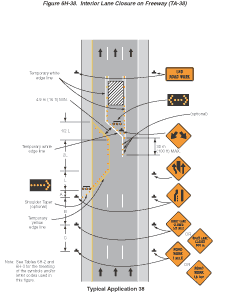
Notes for Figure 6H-39—Typical Application 39
Median Crossover on Freeway
Standard:
- Channelizing devices or temporary traffic barriers
shall be used to separate opposing vehicular traffic.
Guidance:
- For long-term work on high-speed, high-volume
highways, consideration should be given to using a temporary traffic
barrier to separate opposing vehicular traffic.
Option:
- When a temporary traffic barrier is used to separate
opposing vehicular traffic, the Two-Way Traffic, DO NOT PASS,
KEEP RIGHT, and DO NOT ENTER signs may be eliminated.
- The alignment of the crossover may be designed
as a reverse curve.
Guidance:
- When the crossover follows a curved alignment,
the design criteria contained in the AASHTO "Policy on the
Geometric Design of Highways and Streets" should be used
(see Section 1A.11).
- When channelizing devices have the potential
of leading vehicular traffic out of the intended traffic space,
the channelizing devices should be extended a distance in meters
(feet) of 0.4 times the speed limit in km/h (2 times the speed
limit in mph) beyond the end of the transition area as depicted.
- Where channelizing devices are used, the Two-Way
Traffic signs should be repeated every 1.6 km (1 mi).
Option:
- NEXT X km (MILES) Supplemental Distance plaques
may be used with the Two-Way Traffic signs, where X is the distance
to the end of the two-way section.
Support:
- When the distance is sufficiently short that
road users entering the section can see the far end of the section,
they are less likely to forget that there is opposing vehicular
traffic.
- The sign legends for the four pairs of signs
approaching the lane closure for the noncrossover direction of
travel are not shown. They are similar to the series shown for
the crossover direction, except that the left lane is closed.
Figure
6H-39 Median Crossover on Freeway (TA-39)
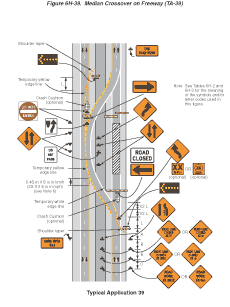
Notes for Figure 6H-40—Typical Application 40
Median Crossover for Entrance Ramp
Guidance:
- The typical application illustrated should
be used for carrying an entrance ramp across a closed directional
roadway of a divided highway.
- A temporary acceleration lane should be used
to facilitate merging.
- When used, the YIELD or STOP sign should be
located far enough forward to provide adequate sight distance
of oncoming mainline vehicular traffic to select a reasonably
safe gap. If needed, YIELD or STOP lines should be installed across
the ramp to indicate the point at which road users should YIELD
or STOP. Also, a longer acceleration lane should be provided beyond
the sign to reduce the gap size needed.
Option:
- If vehicular traffic conditions allow, the ramp
may be closed.
- A broken edge line may be carried across the
temporary entrance ramp to assist in defining the through vehicular
traffic lane.
- When a temporary traffic barrier is used to separate
opposing vehicular traffic, the Two-Way Traffic signs and the
DO NOT ENTER signs may be eliminated.
Figure
6H-40 Median Crossover for Entrance Ramp (TA-40)
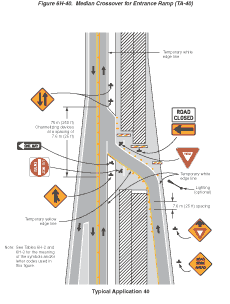
Notes for Figure 6H-41—Typical Application 41
Median Crossover for Exit Ramp
Guidance:
- This typical application should be used for
carrying an exit ramp across a closed directional roadway of a
divided highway. The design criteria contained in the AASHTO "Policy
on the Geometric Design of Highways and Streets" (see Section
1A.11) should be used for determining the curved alignment.
- The guide signs should indicate that the ramp
is open, and where the temporary ramp is located. Conversely,
if the ramp is closed, guide signs should indicate that the ramp
is closed.
- When the exit is closed, a black on orange
EXIT CLOSED panel should be placed diagonally across the interchange/intersection
guide signs.
- In the situation (not shown) where channelizing
devices are placed along the mainline roadway, the devices’
spacing should be reduced in the vicinity of the off ramp to emphasize
the opening at the ramp itself. Channelizing devices and/or temporary
pavement markings should be placed on both sides of the temporary
ramp where it crosses the median and the closed roadway.
- Advance guide signs providing information related
to the temporary exit should be relocated or duplicated adjacent
to the temporary roadway.
Standard:
- A temporary EXIT sign shall be located in the
temporary gore. For better visibility, it shall be mounted a minimum
of 2.1 m (7 ft) from the pavement surface to the bottom of the
sign.
Option:
- Guide signs referring to the exit may need to
be relocated to the median.
- The temporary EXIT sign placed in the temporary
gore may be either black on orange or white on green.
- In some instances, a temporary deceleration lane
may be useful in facilitating the exiting maneuver.
- When a temporary traffic barrier is used to separate
opposing vehicular traffic, the Two-Way Traffic signs may be omitted.
Figure
6H-41 Median Crossover for Exit Ramp (TA-41)

Notes for Figure 6H-42—Typical Application 42
Work in Vicinity of Exit Ramp
Guidance:
- The guide signs should indicate that the ramp
is open, and where the temporary ramp is located. However, if
the ramp is closed, guide signs should indicate that the ramp
is closed.
- When the exit ramp is closed, a black on orange
EXIT CLOSED panel should be placed diagonally across the interchange/intersection
guide signs.
- The design criteria contained in the AASHTO
“Policy on the Geometric Design of Highways and Streets”
should be used for determining the alignment (see Section
1A.11).
Standard:
- A temporary EXIT sign shall be located in the
temporary gore. For better visibility, it shall be mounted a minimum
of 2.1 m (7 ft) from the pavement surface to the bottom of the
sign.
Option:
- An alternative procedure that may be used is
to channelize exiting vehicular traffic onto the right shoulder
and close the lane as necessary.
Figure
6H-42 Work in Vicinity of Exit Ramp (TA-42)
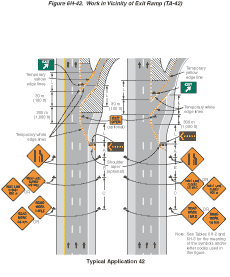
Notes for Figure 6H-43—Typical Application 43
Partial Exit Ramp Closure
Guidance:
- Truck off-tracking should be considered when
determining whether the minimum lane width of 3 m (10 ft) is adequate
(see Section 6G.07).
Figure
6H-43 Partial Exit Ramp Closure (TA-43)
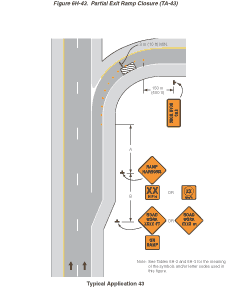
Notes for Figure 6H-44—Typical Application 44
Work in Vicinity of Entrance Ramp
Guidance:
- An acceleration lane of sufficient length should
be provided whenever possible as shown on the left diagram.
Standard:
- For the information shown on the diagram on
the right side of the typical application, where inadequate acceleration
distance exists for the temporary entrance, the YIELD sign shall
be replaced with STOP signs (one on each side of the approach).
Guidance:
- When used, the YIELD or STOP sign should be
located so that ramp vehicular traffic has adequate sight distance
of oncoming mainline vehicular traffic to select a reasonably
safe gap in the mainline vehicular traffic flow. Also, a longer
acceleration lane should be provided beyond the sign to reduce
the gap size needed. If insufficient gaps are available, consideration
should be given to closing the ramp.
- Where STOP signs are used, a temporary stop
line should be placed across the ramp at the desired stop location.
- The mainline merging taper with the arrow panel
at its starting point should be located sufficiently in advance
so that the arrow panel is not confusing to drivers on the entrance
ramp, and so that the mainline merging vehicular traffic from
the lane closure has the opportunity to stabilize before encountering
the vehicular traffic merging from the ramp.
- If the ramp curves sharply to the right, warning
signs with Advisory Speed Limits located in advance of the entrance
terminal should be placed in pairs (one on each side of the ramp).
Option:
- A Type B high-intensity warning flasher with
a red lens may be placed above the STOP sign.
- Where the acceleration distance is significantly
reduced, a supplemental plaque may be placed below the YIELD AHEAD
sign reading NO MERGE AREA.
Figure
6H-44 Work in Vicinity of Entrance Ramp (TA-44)
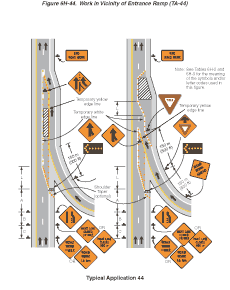
Notes for Figure 6H-45—Typical Application 45
Temporary Reversible Lane Using Movable Barriers
Support:
- This application addresses one of several uses
for movable barriers in highway work zones. In this example, one
side of a 6-lane divided highway is closed to perform the work
operation, and vehicular traffic is carried in both directions
on the remaining 3-lane roadway by means of a median crossover.
To accommodate unbalanced peak-period vehicular traffic volumes,
the direction of travel in the center lane is switched to the
direction having the greater volume, with the transfer typically
being made twice daily. Thus, there are four vehicular traffic
phases described as follows:
- Phase A—two travel lanes northbound
and one lane southbound;
- Transition A to B—one travel lane
in each direction;
- Phase B—one travel lane northbound
and two lanes southbound; and
- Transition B to A—one travel lane
in each direction.
The typical application on the left illustrates
the placement of devices during Phase A. The typical application
on the right shows conditions during the transition (Transition
A to B) from Phase A to Phase B.
Guidance:
- For the reversible-lane situation depicted,
the ends of the movable barrier should terminate in a protected
area or a crash cushion should be provided. During Phase A, the
transfer vehicle should be parked behind the end of the movable
barrier. During Phase B, the transfer vehicle should be parked
behind the end of the movable barrier.
The transition shift from Phase A to B should
be as follows:
- Change the signs in the northbound advance
warning area and transition area from a LEFT LANE CLOSED AHEAD
to a LEFT TWO LANES CLOSED AHEAD. Change the mode of the second
northbound arrow panel from Caution to Right Arrow.
- Place channelizing devices to close the
northbound center lane.
- Move the transfer vehicle from south to
north to shift the movable barrier from the west side to the
east side of the reversible lane.
- Remove the channelizing devices closing
the southbound center lane.
- Change the signs in the southbound transition
area and advance warning area from a LEFT TWO LANES CLOSED
AHEAD to LEFT LANE CLOSED AHEAD. Change the mode of the second
southbound arrow panel from Right Arrow to Caution.
- Where the lane to be opened and closed is an
exterior lane (adjacent to the edge of the traveled way or the
work space), the lane closure should begin by closing the lane
with channelizing devices placed along a merging taper using the
same information employed for a stationary lane closure. The lane
closure should then be extended with the movable-barrier transfer
vehicle moving with vehicular traffic. When opening the lane,
the transfer vehicle should travel against vehicular traffic.
The merging taper should be removed in a method similar to a stationary
lane closure.
Figure
6H-45 Movable Barriers (TA-45)
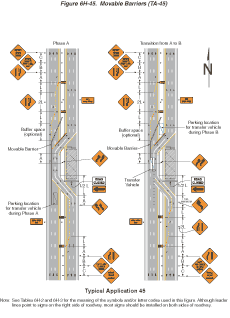
Notes for Figure 6H-46—Typical Application 46
Work in Vicinity of Highway-Rail Grade Crossing
Guidance:
- When highway-rail grade crossings exist either
within or in the vicinity of roadway work activities, extra care
should be taken to minimize the probability of conditions being
created, either by lane restrictions, flagging or other operations,
where vehicles might be stopped within the highway-rail grade
crossing, considered as being 4.6 m (15 ft) on either side of
the closest and farthest rail.
Standard:
- If the queuing of vehicles across active rail
tracks cannot be avoided, a uniformed law enforcement officer
or flagger shall be provided at the highway-rail grade crossing
to prevent vehicles from stopping within the highway-rail grade
crossing (as described in Note 1), even if automatic warning devices
are in place.
Guidance:
- Early coordination with the railroad company
should occur before work starts.
- In the example depicted, the buffer space of
the activity area should be extended upstream of the highway-rail
grade crossing (as shown) so that a queue created by the flagging
operation will not extend across the highway-rail grade crossing.
- The DO NOT STOP ON TRACKS sign should be used
on all approaches to a highway-rail grade crossing within the
limits of a TTC zone.
Option:
- Flashing warning lights and/or flags may be used
to call attention to the advance warning signs.
- A BE PREPARED TO STOP sign may be added to the
sign series.
Guidance:
- When used, the BE PREPARED TO STOP sign should
be located before the Flagger symbol sign.
Standard:
- At night, flagger stations shall be illuminated,
except in emergencies.
Figure
6H-46 Work in Vicinity of Highway-Rail Grade Crossing (TA-46)
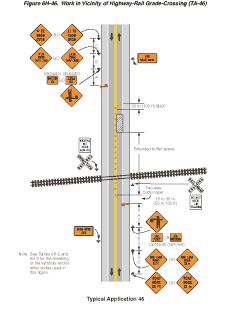
Back to Top
|

